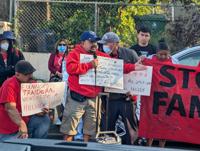A lawsuit against Los Angeles County that alleges that the county is failing to provide resources for transition-age foster youth when they exit foster care can now move forward.
To address the allegations, the office of Mayor Karen Bass announced in a press release that they will be joining forces with the Children's Law Center of California and The RightWay Foundation.
This move comes after a judge made a significant ruling that “affirms the government's responsibility to provide care and shelter to foster youth in foster care beyond the age of 18.”
Los Angeles County has the largest population of foster youth in the United States. There are nearly 437,000 children in foster care in the U.S., while in California the population of foster youth is 60,000, according to the Children’s Law Center of California.
The documents in the case allege that the county is failing to provide resources for transition-age foster youth (TAFY) when they age out of care, leaving them without the necessary resources and support to thrive in adulthood. The Children's Rights, Public Counsel and Alliance for Children's Rights are the firms bringing forth the allegations in this lawsuit.
A 108-page complaint was filed against the county and related departments in the U.S. District Court on behalf of six foster youth ages 17 to 20, one of whom was pregnant during the time the county failed to provide her with a safe living situation.
The lawsuit names the Los Angeles County; Los Angeles County Department of Children and Family Services and Brandon Nichols, director of DCFS; Los Angeles County Department of Mental Health and Lisa Wong, director of DMH; California Health and Human Services (CalHHS) Agency and Mark Ghaly, secretary of the CalHHS Agency; California Department of Social Services and Kim Johnson, director of CDSS; and California Department of Health Care Services and Michelle Baass, director of the California Department of Human Care Services as the defendants of the lawsuit.
According to the complaint, it suggests that “defendants are engaged in six violations of foster youth’s legal rights.”
The six violations from the complaint |
|
Jackson K., a 19-year old Latino teen, is part of the lawsuit because the county has failed on multiple occasions and in different contexts to provide him with a proper interpreter, as his primary language is American Sign Language.
This is not only a violation against his Fourteenth Amendment rights, but also his rights under the American Disabilities Act.
Due to the county’s mismanagement of the case and failure by the police department to provide an interpreter, Jackson. K was placed on a psychiatric hold after calling the police to aid him in reporting his cyber bullies.
According to the complaint, at least two of the youth identify as LGBTQ+, with one of them having experienced homelessness along with their girlfriend during the time they were seeking to stay in extended care.
This marginalization factor significantly increases inequities in accessing resources, according to a Safe Havens II: Interactive Report by Lambda Legal.
Erykah B. is a 19-year-old, Black LGBTQ+ teen who cycled through foster care placements since they were an infant, along with other siblings. Erykah not only experienced a series of unstable placements, sexual assault, homelessness and countless failures to provide basic needs, but they were also diagnosed with Post Traumatic Stress Disorder (PTSD) and depression.
Onyx G. experienced sexual assault at multiple placements. They were also harassed for improper hygiene because they did not know how to tend to their Afro-textured hair and ‘outed’ with their sexual orientation by a staff member who would stare at them for extended periods of time, making them feel uncomfortable.
Rosie S., is a 20 year-old Latina mother who was in foster care since she was eight years old. The young mother was left without health insurance for six months of her pregnancy and was forced to relocate out-of-state and away from her support system.
Ocean S., is a 20-year-old Black mother who has cycled through homelessness, mental health issues and sexual trauma.
Junior R., is a 20-year-old mixed race person in extended foster care. He has cycled through various placements, has witnessed and experienced physical violence in his home and has been diagnosed with depression, anxiety and attention deficit hyperactivity disorder.
Basic needs not only include secure housing, but also access to mental health treatment and support that ensures TAFY are able to keep housing once or if they are able to get it.
Assembly Bill 403 was enacted in 2015 to license and regulate various out-of-home facilities responsible for children and nonminor dependents in foster care. Known as the Continuum of Care Reform, it seeks to ensure that all children live as members of committed, nurturing and permanent families. The County Welfare Directors Association of California stated that “County child welfare agencies are diligently working to implement CCR.”
In order to understand the complexity and intersectionality of this foster care to homelessness issue, it is imperative to factor in the Katie A. v Bonta class action suit. This lawsuit points to the consequences of institutionalizing children and neglecting to address their mental health needs before they become adults and age out.
In 2003, Los Angeles County settled a portion of the lawsuit, agreeing to close the MacLaren Children’s Center and develop appropriate services in the community. By 2005, an expert panel found that the county had not yet developed a plan to provide community services to the 50,000 children in the county’s system.
It wasn’t until 2011 when the parties agreed to a proposal that would provide intensive home- and community-based mental health services for children in foster care. The proposal also suggested that the state would make intensive and home-based services and intensive care coordination under Medicaid and would then also determine what parts of therapeutic foster care are covered by Medicaid, providing that care be given to those who qualify under Medicaid.
The lawsuit against Los Angeles County last summer alleged the county was failing to provide foster youth who age out of care with adequate resources and stable housing. The time frame considered in the lawsuit goes back to 2015.
Transition age youth are between the ages of 16 and 21. During this time, Los Angeles County is responsible for dependents as “wards of the court.” The official 2024 California Rules of Court state that, there are a number of steps and requirements to continue living under state care.
Wards of the court are what the state of California calls foster youth and youth who are in the juvenile justice system.
In 2021, the Prison Journalism Project reported on the “foster care to prison pipeline,” where former editorial associate Arthur Longworth spoke about his experience with the pipeline.
In the article about his experience growing up in foster care, he states that “prison is exactly where you were raised to be.”
According to a study by the Youth Law Center, “At any given time, there are approximately 42,823 children housed in institutions and other group facilities. The trends of abuse, lack of mental health support, and racial inequality within child welfare institutions have harmed children and families for too long – and our history clearly shows that you cannot fix a fundamentally bad practice. It just needs to end.”
This study’s aim was to highlight the trends that foster youth experience through the institutionalization of their care and support.
On a personal note, I am a former foster youth who was put in foster care at the age of 16. My case closed when I aged out at 18 and by 19, I became homeless. I couldn’t afford an apartment and I had no credit or rental history, so I moved in with an ex-partner and became homeless again a year later. I couch surfed through different living situations and eventually had to move back in with my unstable family dynamic.
During that time, I couldn’t go to shelters because I was unwilling to give up my dog, who I had since I was nine years old and was my only emotional support.
My lifeline became my counselors at East Los Angeles College’s Educational Opportunity program. They made sure I had food, water, a backpack, supplies, textbooks and a place to study. I only learned about college tuition support for foster youth through financial aid documents and doing my own research. My case worker during my time in foster care failed to mention that I would get that support at a community college.
I slept in my car during the winter of 2019, the same year I graduated from community college with honors, a certificate of completion, a transfer degree, a general studies degree and got an acceptance letter from California State University, Long Beach.
I experienced prolonged stress, trauma, insomnia and health issues related to food insecurity, all of which I still struggle with today.
Earlier this year, Inside Higher Education reported on “prioritizing foster students' success in higher ed,” stating that support programs are crucial in helping bridge the gap to completing college degrees. The article lists “four new or successful collegiate programs to support students formerly in foster care.” The programs aim to support current and former foster youth in achieving their higher education goals.
The foster youth to homelessness pipeline requires a multifaceted approach, with different solutions across the country and at different intersections such as workforce education, higher education, parental care and mental health services, to name a few. Foster youths’ futures in Los Angeles County are determined by resources, access and support from these departments, and if the unanimous expectation for foster youth is that we transition into adulthood to become proactive members of society, we need government support to do it.
If you are a current or former foster youth and need to file a complaint, visit https://fosteryouthhelp.ca.gov/file-a-complaint/










(0) comments
Welcome to the discussion.
Log In
Keep it Clean. Please avoid obscene, vulgar, lewd, racist or sexually-oriented language.
PLEASE TURN OFF YOUR CAPS LOCK.
Don't Threaten. Threats of harming another person will not be tolerated.
Be Truthful. Don't knowingly lie about anyone or anything.
Be Nice. No racism, sexism or any sort of -ism that is degrading to another person.
Be Proactive. Use the 'Report' link on each comment to let us know of abusive posts.
Share with Us. We'd love to hear eyewitness accounts, the history behind an article.